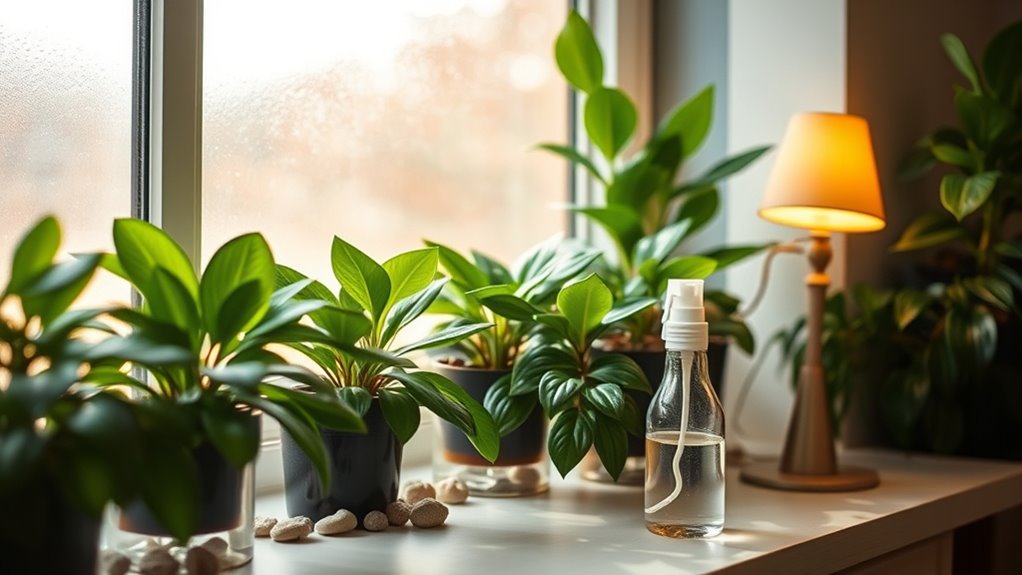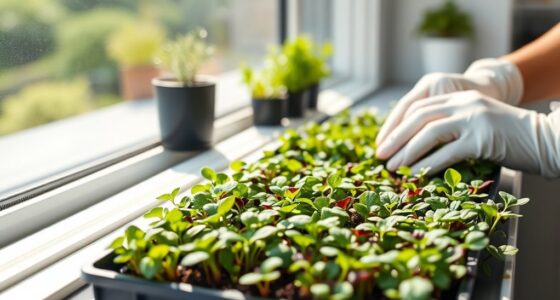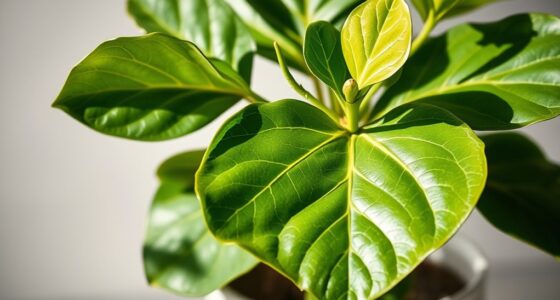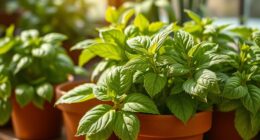During winter dormancy, you can help your houseplants survive the off-season by optimizing light with south or west-facing windows and removing obstructions. Water less often, checking soil moisture before watering to prevent overwatering. Keep temperatures steady and humidity slightly higher with misting or a humidifier. Regularly inspect for pests, prune dead leaves, and avoid fertilizing, knowing growth will likely resume in spring. Keep these tips in mind to support your plants through winter’s quiet period and learn more about each step.
Key Takeaways
- Adjust light exposure by using south or west-facing windows and supplement with grow lights if needed.
- Reduce watering frequency, checking soil moisture before watering to prevent overwatering.
- Maintain stable temperatures and slightly higher humidity; avoid drafts and temperature fluctuations.
- Regularly inspect for pests and stress signs; prune dead leaves and keep plants healthy.
- Refrain from fertilizing during dormancy; focus on environment stability until spring growth resumes.
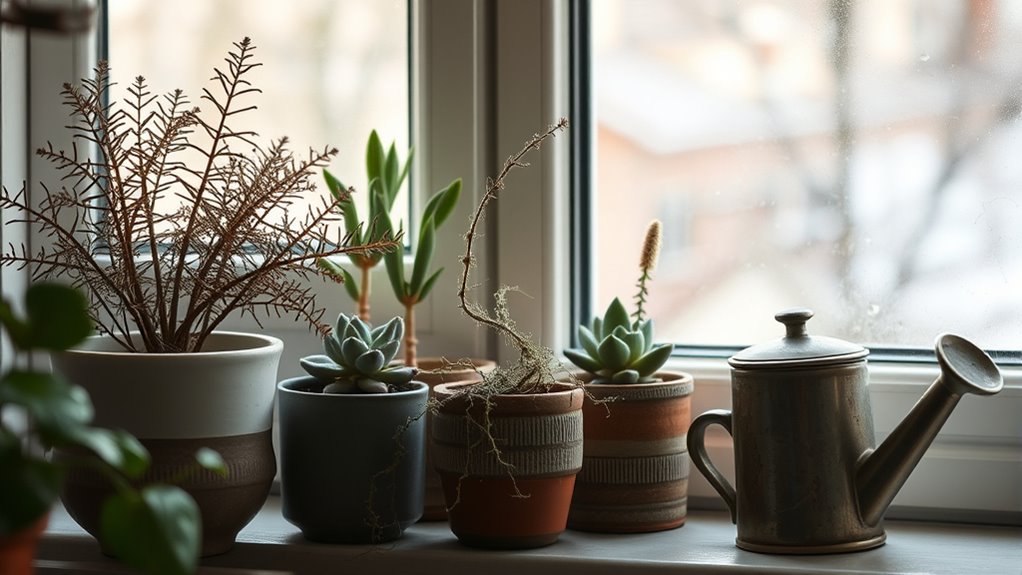
As winter arrives and houseplants enter their dormant phase, it’s important to adjust your care routine to keep them healthy. During this time, light adjustment becomes vital. As natural sunlight diminishes, you need to guarantee your plants still receive enough light to stay healthy, but not too much to cause stress. Place them closer to windows that get the most sunlight, preferably south or west-facing, and clear away any heavy drapes or obstructions. If natural light is limited, consider using grow lights for a few hours each day to supplement their needs. This helps maintain their energy levels and prevents legginess, which is common in low-light conditions.
Adjust your houseplants’ light with south or west-facing windows and grow lights in winter for healthy growth.
Alongside light adjustment, you should also modify your watering schedule. Typically, houseplants require less water during dormancy because their growth slows down. Overwatering can lead to root rot and other issues, so check the top inch of soil before watering. If it feels dry, give your plants a light soak; if it’s still moist, wait a few more days. Remember, consistency is key, but don’t follow a strict schedule—let the moisture level guide you. Also, reduce the frequency of watering compared to their active growing season, but never allow the soil to completely dry out. Proper watering during dormancy helps prevent stress and keeps the roots healthy without encouraging unwanted growth. Additionally, understanding the plant’s specific light needs can significantly influence how well they adapt during this period.
In addition to light and watering, pay attention to the environment’s temperature and humidity. Keep your houseplants in a spot where temperatures stay steady, away from drafts or heating vents that can cause fluctuations. Maintaining a slightly higher humidity level can be beneficial, especially for tropical varieties, so consider misting the leaves occasionally or placing a humidifier nearby. This prevents the plants from drying out and supports their overall health during the off-season.
Regularly check for signs of stress or pests, as winter can sometimes hide issues that become more apparent once conditions change. Prune any dead or yellowing leaves to redirect the plant’s energy and promote healthier growth when the season shifts. Also, avoid fertilizing during dormancy, as plants are not actively growing and won’t absorb nutrients efficiently. Instead, focus on providing the right environment and minimal maintenance until spring arrives and growth resumes.
Frequently Asked Questions
How Often Should I Water My Houseplants During Dormancy?
During dormancy, you should water your houseplants based on their moisture levels, which tend to decrease. Check the soil every 1-2 weeks, and only water when the top inch feels dry. Avoid overwatering, as it can lead to root rot. Adjust the watering frequency according to your plant’s specific needs and environment, ensuring the soil stays slightly moist but not soggy.
Can I Prune My Houseplants During the Winter Dormant Period?
Think of pruning as giving your houseplants a gentle sculptor’s touch. During dormancy, you can prune using careful pruning techniques, but only if you recognize dormancy indicators like slowed growth or leaf shedding. Avoid heavy pruning, as it can stress your plant. Pruning during this period helps shape and remove dead or damaged parts, preparing them for healthy growth when spring arrives. Always prune with clean, sharp tools for best results.
Are There Specific Fertilizers Suitable for Winter Dormancy?
You ask if there are specific fertilizers for winter dormancy. During this time, your houseplants have lower nutrient needs, so use winter-specific fertilizers that are low in nitrogen and higher in potassium and phosphorus. These dormancy nutrient requirements help prevent overfeeding and root stress. Applying a diluted, balanced fertilizer every 4-6 weeks supports your plants without encouraging unnecessary growth, ensuring they stay healthy through the off-season.
How Do I Identify if My Plant Is Truly Dormant or Dying?
Identifying if your plant is truly dormant or dying is like telling if a sleeping bear is just resting or gone. Check plant health and dormancy indicators: look for yellowing leaves, soft stems, or mold, which suggest trouble. Dormant plants typically have minimal growth, firm stems, and intact leaves. If it’s just dormant, it’ll bounce back with proper care; if dying, it’s time to decide whether to salvage or replace.
Should I Move My Houseplants to a Different Location During Dormancy?
You should consider moving your houseplants to a different location during dormancy if lighting adjustments and temperature considerations need improvement. Place them where they get indirect light and maintain a stable, cooler temperature to support their rest period. Avoid drafts and direct sunlight, which can disrupt dormancy. Moving your plants thoughtfully helps them conserve energy and prepares them for healthy growth when spring arrives.
Conclusion
As winter whispers its quiet lullaby, remember that your houseplants are simply taking a gentle pause. By giving them a little extra care and understanding, you help them rest and prepare for brighter days ahead. Think of this season as a graceful retreat—an opportunity for your greenery to gather strength. With patience and kindness, you’ll be rewarded with vibrant growth when spring’s warmth arrives. Embrace the subtle art of winter’s quiet touch, and watch your plants thrive anew.
